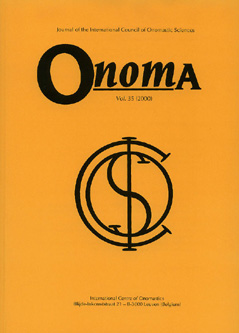 previous article in this issue previous article in this issue | next article in this issue  |

|
Document Details : Title: Odonyms of Buenos Aires and Tarragona Subtitle: A Comparative Approach Author(s): MORI, Olga Journal: Onoma Volume: 42 Date: 2007 Pages: 89-109 DOI: 10.2143/ONO.42.0.2047076 Abstract : The scope of this paper is to compare the odonyms of the European city of Tarragona with those of a South American one, the city of Buenos Aires, in order to establish the grammatical and semantic similarities and differences between both nomenclatures and to elaborate a methodology from a linguistic point of view which can be applied in contrastive onomastic studies. In a comparative approach, it is necessary to classify and analyse the odonyms of each city before comparing them. The fact that odonyms are official proper names determines mainly their structure and use. Besides, historical, sociological, political and geographical influences play an important role in the choice of certain odonyms in each city. The Spanish influence upon city planning as well as upon the designation of the streets in South America is a fact which determines most of the similarities. However, the political aspect which has influenced the choice of many of the actual odonyms in both cities should not be forgotten: the desire to be autonomous from Spain. A comparative analysis shows that the function of odonyms goes far beyond the boundaries of mere identification of urban referents and of the borders of one country; they reflect international relations and influences. L’article a pour but de comparer les noms de rues des villes européenne de Tarragone et sud-américaine de Buenos Aires, afin d’établir les convergences et divergences grammaticales et sémantiques des deux nomenclatures, et d’élaborer une méthodologie linguistique qui puisse être appliquée aux études d’onomastique contrastive. Dans une approche comparative, il convient de classer et d’analyser les noms de chaque ville avant de les comparer. Le caractère officiel des odonymes détermine fortement leur structure et leur usage. En outre, des influences historiques, sociologiques, politiques et géographiques jouent un rôle important dans le choix de certains odonymes de chaque ville. L’influence hispanique sur l’aménagement de la ville et la désignation des rues en Amérique du Sud est un fait qui détermine la plupart des convergences. Cependant, l’aspect politique qui a influé sur le choix de nombre d’odonymes des deux villes ne peut être négligé: le désir d’autonomie vis-à-vis de l’Espagne. Une analyse comparative montre que la fonction des odonymes dépasse les limites d’une simple identification des référents urbains et des frontières d’un pays; elle reflète les relations internationales et leurs influences. Der Beitrag setzt sich zum Ziel, die Hodonymie der europäischen Stadt Tarragona mit der einer südamerikanischen Metropole, nämlich Buenos Aires, zu vergleichen, um grammatische und semantische Ähnlichkeiten und Unterschiede zwischen beiden Namensystemen herauszuarbeiten aus linguistischer Sicht zu einem methodischen Zugang zu gelangen, der sich paradigmatisch auf vergleichende onomastische Untersuchungen anwenden lässt. Bevor die Hodonyme beider Städte diesem Vergleich unterzogen werden können, ist es zunächst notwendig, sie jeweils separat zu klassifizieren und zu analysieren. Die Tatsache, dass es sich bei Hodonymen um offizielle Namen handelt, bestimmt weitgehend ihre Struktur und ihren Gebrauch. Darüber hinaus spielen in beiden Städten historische, soziologische, politische und geographische Einflüsse eine wichtige Rolle bei der Namenwahl. Der spanische Einfluss bei der Stadtplanung wie bei der Straßenbenennung in Südamerika erklärt den größten Teil der Parallelen. Dennoch kann man den politischen Aspekt nicht außer Acht lassen, der die Wahl zahlreicher aktueller Straßennamen in beiden Städten bestimmt hat, nämlich den Wunsch nach Abgrenzung von Spanien. Eine vergleichende Analyse zeigt, dass die Funktion von Straßennamen über eine einfache Identifizierung städtischer Referenzobjekte weit hinausgeht und dabei auch die Ländergrenzen überwunden werden; Straßennamen spiegeln internationale Beziehungen und Einflüsse. |
|
